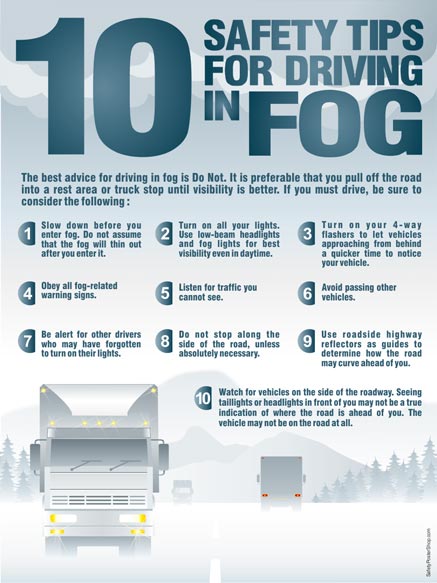You, my intrepid motorists, are about to have your foggy day drives demystified. Prepare to explore the murky challenges of navigating in fog and emerge as driving virtuosos, armed with just the right skills and strategies. Let me illumine your journey through the hazy maze of foggy roads, delivering you unscathed on the other side. Buckle up, you’re in for an enlightening ride on the road less seen.
Table of Contents
Understanding the Dangers of Fog on the Road

Fog may seem like a benign weather anomaly, yet it morphs into a wily, even formidable adversary when faced on the open road. With its ethereal veil that descends suddenly, fog can transform a familiar route into alien territory, impairing visibility and, for the unsuspecting driver, compounding the risk of mishaps by many folds.
Visually, fog is as dense as low-hanging cloud, yet it shrouds the ground-level panorama, wreaking havoc on our depth perception and thereby amplifying the intricacy of maintaining appropriately safe distances from other road users. It’s not just about seeing less; it’s about constantly second-guessing how much less you’re seeing.
The dangers inherent in foggy conditions are two-fold. First, it curtails the perception of speed at which objects and other vehicles are hurtling towards you, or you towards them. You might think you’re cruising comfortably while in reality, you’re unsettlingly close to the car ahead. Second, the slick film of moisture fog drapes over the asphalt surface may render the road slippery, challenging the vehicle’s traction and elongating its braking distances.
Then, there’s the peril of other drivers. Not everyone comprehends the hazards of driving in fog or respects them as they should. You might execute all the right defensive driving strategies, only for a less cautious motorist to show up in your misty tail-lights, intent on tailgating or overtaking. Their overconfidence or ignorance significantly amplifies your personal risk while navigating through the foggy clime.
Driving in fog is like playing a real-life game of bumper cars, just without the safety nets (or fun). You must reassure yourself that the vehicles are there, somewhere in that opaque swirl, even if you can’t see them. And that in itself is half the battle won against the fog – acknowledging its dangers and adjusting your driving techniques accordingly. So buckle up, lower your speed dial, and let’s delve deeper into pre-emptive measures and best practices to keep you safe from the fog’s foggy grasp.
Precautions to Take Before Driving in Fog

Stepping into a car for a foggy drive is comparable to walking into a mystical and perilously unpredictable ambiance. It’s like playing a real-life version of a low-visibility video game—only now, the stakes are significantly higher. But fret not good folks, there are definite measures we can put in place to make that foggy journey safer and less unnerving.
Let’s begin with the first golden rule: delaying the trip. Yes, if the journey isn’t critical and can be postponed, camp out at home with some coffee and binge on Netflix until visibility improves. The hazards of fog are undisputed. So, if displaying your grit on fog-choked highways isn’t on your to-do list, give it a raincheck.
However, if travel is unavoidable, it’s crucial to check your rig before tackling the fog. Ensuring all your vehicle’s lights are functioning is a good place to start. Headlights, tail lights, and, particularly, fog lights, need to be in optimum condition to serve their purpose.
Additionally, give your windshield and windows a thorough cleaning, inside and out. Perceive it as wiping the lens on your fog-strewn glasses. Fog already compromises visibility, and dirt or streaks on your glass only compound the issue.
Paying attention to the tire forecast, yes, you heard it right, is another vital check. The tire pressure should be within the manufacturer’s stipulated range, providing you with the best grip and control during these soupy drives.
Let’s not forget to ensure our windshield wipers are in good working condition. It’s immensely frustrating to have a set of squeaky, streak-leaving wipers when you’re trying to maintain a clear view. Rain, mist, dew – foggy conditions can often be associated with damp, so it won’t hurt ensuring your wipers can provide you an unobstructed windshield.
The navigation system deserves a double-check too. Setting your route, knowing alternate roads, and understanding the overall travel landscape upfront saves you from last-minute scrolling while in motion.
Finally, buckle up for a generic but significant reminder: fuel check. It might be the oldest trick in the book, but one never knows how long a foggy drive may take or where the nearest fuel station might be.
So, alright, the homework is done! You’ve prepared better than a Doomsday Prepper facing a fog apocalypse. Now, it’s time to get behind the wheels and face the foggy music. But remember, the foggy drive needs more than preparation; it demands your patience, alertness, and constant adaptation to the ever-changing foggy theater outside.
Best Practices while Driving in Fog

Honing your driving skills to an art form means being prepared for any eventuality—even Mother Nature throwing her occasional curveball, in the form of the ethereal obscurity that is fog. Sight is an indispensable tool behind the wheel, and the fog’s audacious assault on that particular sense is what evokes palpitations in many drivers. So, let’s cut through the mystery and steer right into the heart of the matter.
First off, while you’re skimming the fog with your trained eyes, it is crucial not to be overconfident – yes, you’re channeling Steve McQueen in ‘Bullitt’, but this is reality. Even if you consider yourself an ace driver, high speeds are a no-no. Remember the old adage: speed thrills but also kills. Keep your foot off the gas, slow and steady, full control of your metal steed. You are not aiming for a podium finish; your prize is safe arrival at your destination.
Then there’s the matter of headlamp use. Dipping into popular opinion, many preach the gospel of high-beam use in fog, but that’s a myth! On the contrary, you should dial down the lumens. Low beam headlights are your best bet against the fog’s grey curtain—it angles down, illuminating the road and reducing glare.
Turning to the world of switchgear, most modern vehicles are fitted with fog lights, often both front and rear. Take advantage of this feature, as they have shorter and wider beam spread. Make sure to deactivate them when visibility improves, for they can be a blinding rendezvous for fellow roadsters.
Now, we are not decrying the use of technology. GPS and other satellite-assisted nosy parkers can help with visibility to some extent. However, don’t be entirely subservient to your digital guide. Keep an eye on road markings, or lack thereof. Use the right edge “line”, pedestrian paths or other road boundaries to navigate when things get too dire.
Practice spatial diplomacy with other drivers. Maintain safe distances, avoiding fraternizing with their rear lights. Remember, fog can escalate from a mere nuisance to a whiteout in a matter of meters, making sudden halts a dangerous gamble.
Finally, be generous with your own signals. Flash those indicators with fervour. Two blinks to the right or left can mean the difference between an uneventful journey and a rendezvous with the metal benders.
Mastering fog driving is not rocket science; it’s all about understanding the conditions, reducing speed, keeping safe distances, and using the right lighting. Throw in a dose of patience, and you can turn menacing fog into just another day out cruising.
Useful Tools and Equipment for Foggy Conditions
Fog is synonymous with reduced visibility and can make any highway look like a scene from a suspense thriller. But fear not, armed with the right tools and equipment, you can navigate this nebulous phenomenon with confidence. Let’s take a look at some of the must-haves for driving in foggy conditions.
1. Fog Lights: While low-beam headlights are good, fog lights are better at cutting through the murk because they are mounted low on the vehicle to illuminate the road directly ahead, reducing the glare from the fog. They emit a flat, wide beam that can make the difference between spotting an obstacle on the road or having a heart-stopping moment.
2. Reflective Gear: Another way to combat the low visibility of fog is to make your vehicle more noticeable to others. Reflective tape on the vehicle’s sides and back can provide other drivers with some warning of your presence, and adds an extra layer of safety.
3. Windshield Defoggers: Fog can make your windshield as murky as the road ahead. A windshield defogger helps clear the fog on your windshield and maintains visibility. There are a variety of defoggers available, from inbuilt car options, to portable ones.
4. Hazard Lights: In some cases, fog can be so dense that it’s difficult to see the vehicle ahead till you’re dangerously close. In such scenarios, having your hazard lights on can alert drivers behind you, adding a critical buffer of safety.
5. GPS Navigation: Navigating through fog can be harrowing because visibility of road signs and landmarks diminish. In such situations, GPS navigation becomes an absolute must. Modern systems can even alert you to slowdowns and accidents ahead, reducing the chance of collisions.
6. Traction Mats: Foggy conditions often go hand in hand with damp roads, which can cause vehicles, particularly those with worn tires, to lose traction. Having traction mats onboard can help get your vehicle moving again if it’s stuck.
7. Good Quality Wipers: Rain and fog can create a film on windshields which make it harder to see. Opting for good quality windshield wipers that can clear the windshield efficiently is crucial.
Having these tools and equipment in your fog-fighting arsenal can provide you with the edge you need to drive safely in foggy conditions. Remember, safety is paramount, and arming yourself with these items will give you a head start when facing those foggy challenges on the road.
FAQs
How can I drive safely in fog?
Imagine an epic game of Marco Polo with your car’s headlights … that’s what we’re doing here. Start by slowing down to keep enough distance. You don’t want to say hello to the car ahead with your hood ornament. Always use your headlights, not the high beams. This isn’t a headbanger’s concert, and you don’t want excess light reflecting back. Squirrel away your pride and activate the fog lamps if you have them — they’re like belly-mounted lightsabres slicing the soup!
Is it good practice to follow the taillights of the car ahead?
Sure, it sounds like a sensible idea to follow the lights in the gloom like a moth to a flame. But guess what? Cars can get lost too, and if you follow one recklessly, you’ll be starring in the car version of “Lost in Space”. So no tailgating, love. Give enough space and keep your attention on the road, not just on the glittery taillights.
What should I do in case of severe fog?
If you encounter a fog so heavy it feels like you ended up on a spacewalk around a nebula, then it’s time to call a pit-stop. Pull over as far to the right as you can, activate your hazard lights and park it like it’s hot. Grab a cuppa from your travel mug, sit down, and relax to avoid starring in a fog-induced fender-bender.
Conclusion
From reduced visibility to slick road conditions, fog can indeed be a formidable foe for drivers. But, by employing a few simple strategies such as slowing down, using low beam lights, and not hesitating to pull over if conditions worsen, we can all do our part to mitigate the potential dangers. Remember, brave isn’t the one who speeds through the fog, but the one who knows when to slow down and stay safe. Here’s to clearer skies and safe travels!
